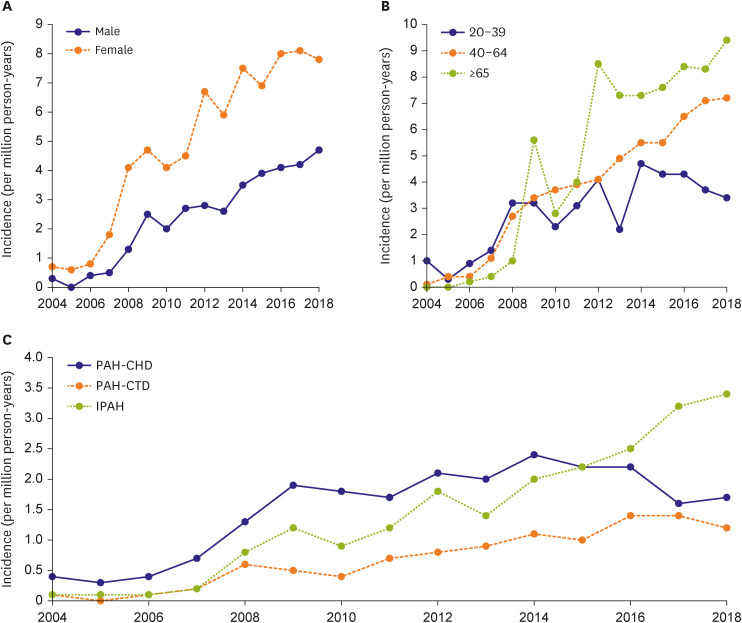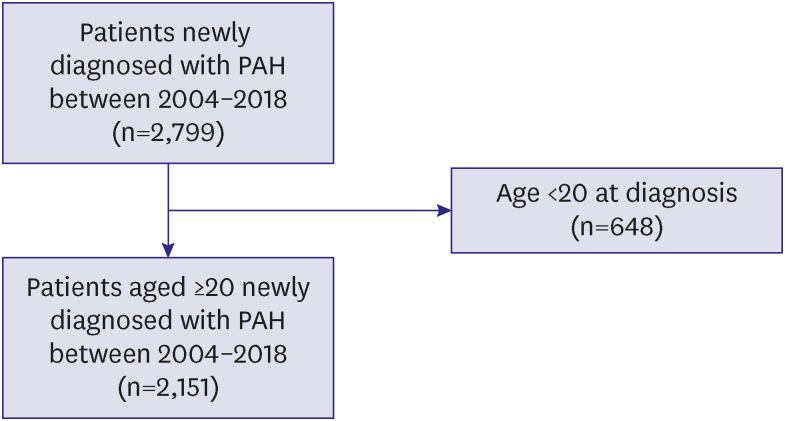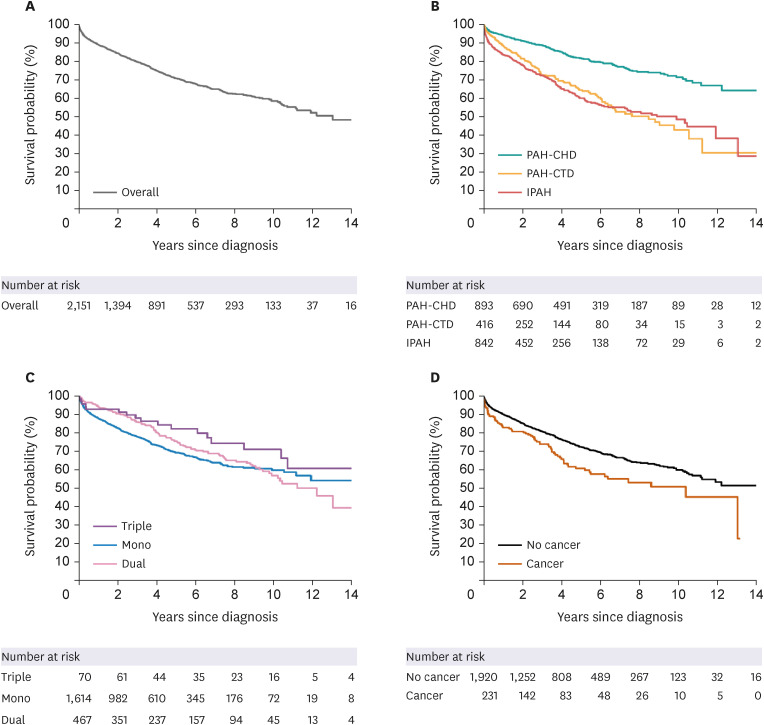Epidemiology of PAH in Korea: An Analysis of the National Health Insurance Data, 2002–2018
- Affiliations
-
- 1Gachon Cardiovascular Research Institute, Gachon University, Incheon, Korea
- 2Division of Cardiovascular Disease, Department of Internal Medicine, Gachon University Gil Medical Center, Incheon, Korea
- 3Department of Preventive Medicine, Yonsei University College of Medicine, Seoul, Korea
- 4Department of Internal Medicine, Yonsei University College of Medicine, Seoul, Korea
- KMID: 2542301
- DOI: http://doi.org/10.4070/kcj.2022.0231
Abstract
- Background and Objectives
Pulmonary arterial hypertension (PAH) is a rare but fatal disease. Recent advances in PAH-specific drugs have improved its outcomes, although the healthcare burden of novel therapeutics may lead to a discrepancy in outcomes between developing and developed countries. We analyzed how the epidemiology and clinical features of PAH has changed through the rapidly advancing healthcare infrastructure in South Korea.
Methods
PAH was defined according to a newly devised 3-component algorithm. Using a nationwide health insurance claims database, we delineated annual trends in the prevalence, incidence, medication prescription pattern, and 5-year survival of PAH in Korea. Cumulative survival and potential predictors of mortality were also assessed among 2,151 incident PAH cases.
Results
Between 2002 or 2004 and 2018, the prevalence and incidence of PAH increased 75-fold (0.4 to 29.9 per million people) and 12-fold (0.5 to 6.3 per million person-years), respectively. The proportion of patients on combination PAH-specific drug therapy has also steadily increased up to 29.0% in 2018. Among 2,151 incident PAH cases (median [interquartile range] age, 50 [37–62] years; 67.2% female), the 5-year survival rate and median survival duration were 71.8% and 13.1 years, respectively. Independent predictors of mortality were age, sex, etiology of PAH, diabetes, dyslipidemia, and chronic kidney disease.
Conclusions
This nationwide study delineated that the prevalence and incidence of PAH have grown rapidly in Korea since the early 2000s. The use of combination therapy has also increased, and the 5-year survival rate of PAH in Korea was similar to those in western countries.
Figure
Cited by 3 articles
-
Current Trends and Movements in Managing Pulmonary Arterial Hypertension in Korea
Jaeho Seung, Hun-Jun Park
Korean Circ J. 2023;53(5):328-330. doi: 10.4070/kcj.2023.0039.A Single Center Experience of Pulmonary Arterial Hypertension Management in Korea: A 25-Year Comparative Analysis Following the Introduction of Targeted Therapy
Ji Hyun Cha, Shin Yi Jang, Jinyoung Song, I-Seok Kang, June Huh, Taek Kyu Park, Jeong Hoon Yang, Seung Woo Park, Hojoong Kim, Duk-Kyung Kim, Sung-A Chang
Korean Circ J. 2024;54(10):636-650. doi: 10.4070/kcj.2023.0316.A 25-Year Journey in the Fight Against Pulmonary Arterial Hypertension at a Korean Center: What Has Changed and What Is Missing?
Jung Hyun Choi, Jae Hyeong Park
Korean Circ J. 2024;54(10):651-652. doi: 10.4070/kcj.2024.0314.
Reference
-
1. Jang AY, Chung WJ. Current status of pulmonary arterial hypertension in Korea. Korean J Intern Med. 2019; 34:696–707. PMID: 31272141.
Article2. Oh S, Jung JH, Ahn KJ, et al. Stem cell and exosome therapy in pulmonary hypertension. Korean Circ J. 2022; 52:110–122. PMID: 35128849.
Article3. Gillmeyer KR, Lee MM, Link AP, Klings ES, Rinne ST, Wiener RS. Accuracy of algorithms to identify pulmonary arterial hypertension in administrative data: a systematic review. Chest. 2019; 155:680–688. PMID: 30471268.
Article4. Ahn KJ, Jang AY, Park SJ, Chung WJ. 15 years journey of idiopathic pulmonary arterial hypertension with BMPR2 mutation. Clin Hypertens. 2019; 25:22. PMID: 31583114.
Article5. Choi EK. Cardiovascular research using the Korean National Health Information Database. Korean Circ J. 2020; 50:754–772. PMID: 32725984.
Article6. Lee HY, Lee SW, Kim HC, Ihm SH, Park SH, Kim TH. Cost-effectiveness analysis of hypertension screening in the Korea National Health Screening Program. Korean Circ J. 2021; 51:610–622. PMID: 34085434.
Article7. Kim HC, Cho SM, Lee H, et al. Korea hypertension fact sheet 2020: analysis of nationwide population-based data. Clin Hypertens. 2021; 27:8. PMID: 33715619.
Article8. Ko SH, Han K, Lee YH, et al. Past and current status of adult type 2 diabetes mellitus management in Korea: a national health insurance service database analysis. Diabetes Metab J. 2018; 42:93–100. PMID: 29676539.
Article9. Cho SM, Lee H, Lee HH, et al. Dyslipidemia fact sheets in Korea 2020: an analysis of nationwide population-based data. J Lipid Atheroscler. 2021; 10:202–209. PMID: 34095012.
Article10. Gall H, Felix JF, Schneck FK, et al. The giessen pulmonary hypertension registry: survival in pulmonary hypertension subgroups. J Heart Lung Transplant. 2017; 36:957–967. PMID: 28302503.
Article11. Wijeratne DT, Lajkosz K, Brogly SB, et al. increasing incidence and prevalence of World Health Organization groups 1 to 4 pulmonary hypertension: a population-based cohort study in Ontario, Canada. Circ Cardiovasc Qual Outcomes. 2018; 11:e003973. PMID: 29444925.
Article12. Anand V, Roy SS, Archer SL, et al. Trends and outcomes of pulmonary arterial hypertension-related hospitalizations in the United States: analysis of the nationwide inpatient sample database from 2001 through 2012. JAMA Cardiol. 2016; 1:1021–1029. PMID: 27851838.
Article13. Lim SS, Lee W, Kim YK, et al. The cumulative incidence and trends of rare diseases in South Korea: a nationwide study of the administrative data from the National Health Insurance Service database from 2011–2015. Orphanet J Rare Dis. 2019; 14:49. PMID: 30777110.
Article14. Mayeux JD, Pan IZ, Dechand J, et al. Management of pulmonary arterial hypertension. Curr Cardiovasc Risk Rep. 2021; 15:2. PMID: 33224405.
Article15. Chung WJ, Park YB, Jeon CH, et al. Baseline characteristics of the Korean registry of pulmonary arterial hypertension. J Korean Med Sci. 2015; 30:1429–1438. PMID: 26425039.
Article16. Greiner S, Jud A, Aurich M, et al. Reliability of noninvasive assessment of systolic pulmonary artery pressure by Doppler echocardiography compared to right heart catheterization: analysis in a large patient population. J Am Heart Assoc. 2014; 3:3.
Article17. Song S, Lee SE, Oh SK, et al. Demographics, treatment trends, and survival rate in incident pulmonary artery hypertension in Korea: a nationwide study based on the health insurance review and assessment service database. PLoS One. 2018; 13:e0209148. PMID: 30566510.
Article18. D’Alonzo GE, Barst RJ, Ayres SM, et al. Survival in patients with primary pulmonary hypertension. Results from a national prospective registry. Ann Intern Med. 1991; 115:343–349. PMID: 1863023.19. Farber HW, Miller DP, Poms AD, et al. Five-year outcomes of patients enrolled in the REVEAL registry. Chest. 2015; 148:1043–1054. PMID: 26066077.
Article20. Hoeper MM, Kramer T, Pan Z, et al. Mortality in pulmonary arterial hypertension: prediction by the 2015 European pulmonary hypertension guidelines risk stratification model. Eur Respir J. 2017; 50:1700740. PMID: 28775047.
Article21. Jing ZC, Xu XQ, Han ZY, et al. Registry and survival study in chinese patients with idiopathic and familial pulmonary arterial hypertension. Chest. 2007; 132:373–379. PMID: 17400671.
Article22. Zeng WJ, Sun YJ, Gu Q, Xiong CM, Li JJ, He JG. The impact of pulmonary arterial hypertension-targeted therapy on survival in Chinese patients with idiopathic pulmonary arterial hypertension. Pulm Circ. 2012; 2:373–378. PMID: 23130106.
Article23. Kozu K, Sugimura K, Ito M, et al. Current status of long-term prognosis among all subtypes of pulmonary hypertension in Japan. Int J Cardiol. 2020; 300:228–235. PMID: 31813677.
Article24. Chang WT, Weng SF, Hsu CH, et al. Prognostic factors in patients with pulmonary hypertension-a nationwide cohort study. J Am Heart Assoc. 2016; 5:e003579. PMID: 27572822.
Article25. Fukuda K, Date H, Doi S, et al. Guidelines for the treatment of pulmonary hypertension (JCS 2017/JPCPHS 2017). Circ J. 2019; 83:842–945. PMID: 30853682.
Article26. Klinger JR, Elliott CG, Levine DJ, et al. Therapy for pulmonary arterial hypertension in adults: update of the CHEST guideline and expert panel report. Chest. 2019; 155:565–586. PMID: 30660783.
Article27. Jang AY, Kim BG, Kwon S, et al. Prevalence and clinical features of bone morphogenetic protein receptor type 2 mutation in Korean idiopathic pulmonary arterial hypertension patients: the PILGRIM explorative cohort. PLoS One. 2020; 15:e0238698. PMID: 32966279.
Article28. Jang AY, Kim S, Park SJ, et al. A Nationwide multicenter registry and biobank program for deep phenotyping of idiopathic and hereditary pulmonary arterial hypertension in Korea: the PAH platform for deep phenotyping in Korean subjects (PHOENIKS) cohort. Clin Hypertens. 2019; 25:21. PMID: 31534782.
Article
- Full Text Links
- Actions
-
Cited
- CITED
-
- Close
- Share
- Similar articles
-
- Utilization of health insurance data in an environmental epidemiology
- Current status of pulmonary arterial hypertension in Korea
- Potentially Avoidable Hospitalization among Long-Term Care Insurance Beneficiaries with Dementia
- Introducing big data analysis using data from National Health Insurance Service
- The late Prof. Byung Yik Kim's suggestions on financial stability of the Korea's national health insurance in 2001 and 2002: what is changed in 10 years?





